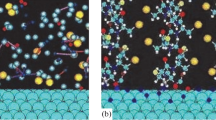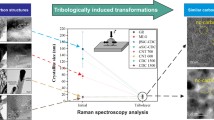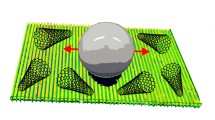Abstract
The reaction behavior of the siloxane on carbon materials was investigated. Under the exposure of the low molecular cyclic siloxane such as D4 (octamethyl cyclotetrasiloxane) to both of graphite and a disk coated by a diamond-like carbon (DLC), polar functional groups on carbon materials worked as a catalyst, generating D5 (decamethyl cyclopentasiloxane), D6 (dodecamethyl cyclohexasiloxane) and cyclic siloxanes with a larger molecular weight. By coating of perfluoro polyether (PFPE) lubricants to DLC and graphite, the adsorption amount of D4 was reduced. Furthermore, the PFPE lubricants covered the polar functional group on the surface of carbon materials and deactivated it, so that the generation of D5, D6 and other larger molecular weight cyclic siloxanes were inhibited. It is proposed that these results indicate the behavior of siloxanes on a hard disk under static conditions.












Similar content being viewed by others
References
Bannister DJ, Semlyen JA (1981) Studies of cyclic and linear poly (dimethylsiloxanes): 6. Effect of heat. Polymer 22:377–381
Boehm HP (2002) Surface oxide on carbon and their analysis: a critical assessment. Carbon 40:145–149
Burgess R, Buono C, Davies PR, Davies RJ, Legge T, Lai A, Lewis R, Morgan DJ, Robinson N, Willock DJ (2015) The functionalisation of graphite surfaces with nitric acid: identification of functional groups and their effects on gold deposition. J Catal 323:10–18
Camino G, Lomakin SM, Lazzari M (2000) Polydimethylsiloxane thermal degradation Part 1. Kinetic aspects. Polymer 42:2395–2402
Camino G, Lomakin SM, Lageard M (2002) Thermal polydimethylsiloxane degradation part 2. The degradation mechanisms. Polymer 43:2011–2015
Kasai PH, Eng FP (2000) Silicon oxide formation in the disk environment. J Inf Storage Process Syst 2:125–128
Kasai PH, Shimizu T (2012) Bonding of hard disk lubricants with OH-bearing end groups. Tribol Lett 46:43–47
Reinso FR (1998) The role of carbon materials in heterogeneous catalysis. Carbon 36(3):159–178
Waltman R (2014) The adsorbed film structure of end-functionalized poly (perfluoro-n-propylene oxide). Tribol Online 9(3):113–120
Author information
Authors and Affiliations
Corresponding author
Additional information
Publisher's Note
Springer Nature remains neutral with regard to jurisdictional claims in published maps and institutional affiliations.
Rights and permissions
About this article
Cite this article
Shimizu, T., Tani, H. The polymerization reaction of cyclic siloxanes on a hard disk under static conditions. Microsyst Technol 24, 4519–4525 (2018). https://doi.org/10.1007/s00542-018-3952-9
Received:
Accepted:
Published:
Issue Date:
DOI: https://doi.org/10.1007/s00542-018-3952-9




